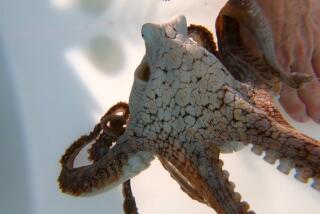State Orders Squid Boats to Dim Lights in Bird Nesting Areas
- Share via
LONG BEACH — Fishing boats can continue to hunt squid around the islands off Ventura County’s coast, but they will be required to dim powerful lights suspected of causing nesting problems for rare, seafaring birds under restrictions imposed Friday by state wildlife authorities.
Confronted with dozens of angry fishermen at its regular monthly meeting, the state Fish and Game Commission acquiesced to the fishermen’s demands and unanimously voted for measures that cut by half the amount of power many boats now use to illuminate lights to lure squid to the surface during nighttime forays. The commission rejected a more stringent remedy, supported by scientists and federal wildlife authorities, to close three islands to fishing for seven months each year.
In an unusual show of solidarity, about 75 squid fishermen from San Diego to Monterey attended the all-day meeting to press their case.
They agreed to skip fishing Thursday night so they could make it to the meeting on time, a sign of growing unity against new regulations among squid fishermen renowned for rivalries that occasionally erupt in attempted boat-ramming and gunfire on the high seas.
“It signals the fishermen are tired of getting run over and if we don’t get out and say something, we’re going to lose our livelihood,” Don Brockman, who lives in Newport Beach and owns two squid boats operating out of Channel Islands Harbor in Oxnard, said after the meeting.
Under the new restrictions, lights on squid boats cannot use more than 30,000 kilowatts of energy.
Many of the 270 boats with permits to fish for squid in California waters have been using twice that amount. When several boats congregate, the midnight glow lights the horizon and on clear nights is visible from Newport Beach to Santa Barbara.
The commission also required that squid boats install light-deflecting shields to direct the luminescence onto the water instead of into the air. The controls, which apply to squid fleets operating anywhere in the state, also had the endorsement of state Department of Fish and Game staff members. They will take effect on an unspecified date later this year.
“We’re still concerned about the birds, but the proposed limits on maximum wattage will prevent the interaction between light and birds,” said Marija Vojkovich, senior biologist for the department.
Federal wildlife authorities, charged with protecting the islands, the surrounding waters and the wildlife that inhabits them, urged the commission to take stronger action.
They advocated closing San Miguel, Santa Barbara and Anacapa islands to squid fishing between February and August. That proposal was endorsed by the U.S. Fish & Wildlife Service, Channel Islands National Marine Sanctuary and several scientists.
William Sydeman, director of the Point Reyes Bird Observatory and a member of the Squid Research Scientific Committee, described the decision by the commission Friday as “totally inadequate.”
*
He said recent tests conducted at Catalina Island showed the remedies the commission approved do not significantly reduce the illumination from squid boats, though state officials and industry representatives dispute that.
“It won’t work and it is insufficient,” Sydeman said. “The lighting will still cause the disturbance and increased predation” on some seabirds.
Fishermen, however, vigorously objected to closing the islands, fearing that would represent a first step toward creating large fishing-free zones along the Central Coast. Channel Islands National Park officials, joined by many leading marine scientists and environmental groups, seek a long-range plan to close as much as 20% of the waters around the five northern Channel Islands to restore depleted fish stocks.
Schools of squid are abundant for now, though the number of boats seeking to turn the palm-sized mollusks into calamari has tripled in the past 10 years in California. About 75,000 tons of squid have been netted since April, and 7% or less of that catch comes from Anacapa, Santa Barbara and San Miguel islands, according to industry and government officials.
Scientists blame bright lights on squid boats for disrupting feeding and nesting patterns of rare birds, including brown pelicans, Xantu’s murrelets and ashy-storm petrels. Those birds frequent the islands and surrounding ocean to forage and mate. In recent years, those species have suffered significant losses of eggs and young.
Scientists suspect the lights may scare birds off nests and attract avian predators, though it is unclear what role is played by other factors, ranging from rats and mice on the islands to changing ocean conditions.
The Fish and Game Commission directed staff members to collect additional information on the birds, which may be used in the decision on future regulations affecting island wildlife and Southern California’s squid-fishing fleet.
More to Read
Sign up for Essential California
The most important California stories and recommendations in your inbox every morning.
You may occasionally receive promotional content from the Los Angeles Times.










